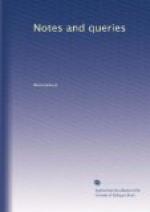If “proof” is a substantive, “massy proof” is in apposition to “antique pillars,” and is very meaningless. Can any of your readers suggest an explanation?
H.A.B.
"Mooney’s Goose."—As a pendant to “Ludlam’s dog,” I beg to insert the proverb of “Full of fun and fooster, like Mooney’s goose,” with the hope that your acute and ingenious correspondent D.V.S. may be able to throw some light upon “Mooney.” Let me add that D.V.S. has perhaps somewhat misconceived my brief comment on Ludlam, which my regard for conciseness has left some deal obscure; and it does not appear worth while to go over the ground again. I repeatedly heard “Dick’s hat-band” quoted by Lancashire friends exactly as given by Southey. Does not the variation “cobbler’s dog” tend to prove the alliterative principle for which I had been contending?
J.M.B.
Translation of the Philobiblon.—Where can I procure a translation of Robert de Bury’s Philobiblon?
L.S.{154}
Achilles and the Tortoise.—Where is the paradox of “Achilles and the Tortoise” to be found? Leibnitz is said to have given it solution in some part of his works.
There is also a geometrical treatment of the subject by Gregoire de S. Vincent. Will some reading man oblige me with information or reference concerning it.
[Greek: Idiotaes.]
Dominicals.—I am desirous of obtaining information on a subject of much interest to Exeter.
An ancient payment is made to the rectors of each parish within the city of Exeter, called “Dominicals,” amounting to 1d. per week from every householder within the parish. Payments of a similar nature are made in London, Canterbury, and I believe Worcester. Can any of your numerous readers state the origin of Dominicals, and give any information respecting them.
W.R.C.
Yorkshire Dales.—A Pedestrian would be much obliged by being informed if there is any map, guide, or description published, that would serve as a hand-book to the Dales in the West Riding of Yorkshire, between Lancashire and Westmoreland.
* * * * *
REPLIES
TOBACCO IN THE EAST.
In the Edinburgh Cabinet Library, vol. iii. p. 383., art. “China,” it is stated that three species of tobacco have been found in India and in China, under circumstances which can leave no doubt of their being native plants.
Dr. Bigelow (American Botany, 4to., vol. ii. p. 171.) tells us that Nicot. fructicosa is said to have been cultivated in the East prior to the discovery of America. Linnaeus sets down the same as a native of China and the Cape of Good Hope. Sir G. Staunton says that there is no traditional account of the introduction of tobacco into China; nor is there any account of its introduction into India[2]; though, according to Barrow, the time when the cotton plant was introduced into the southern provinces of China is noted in their annals. Bell of Antermony, who was in China in 1721, says,




